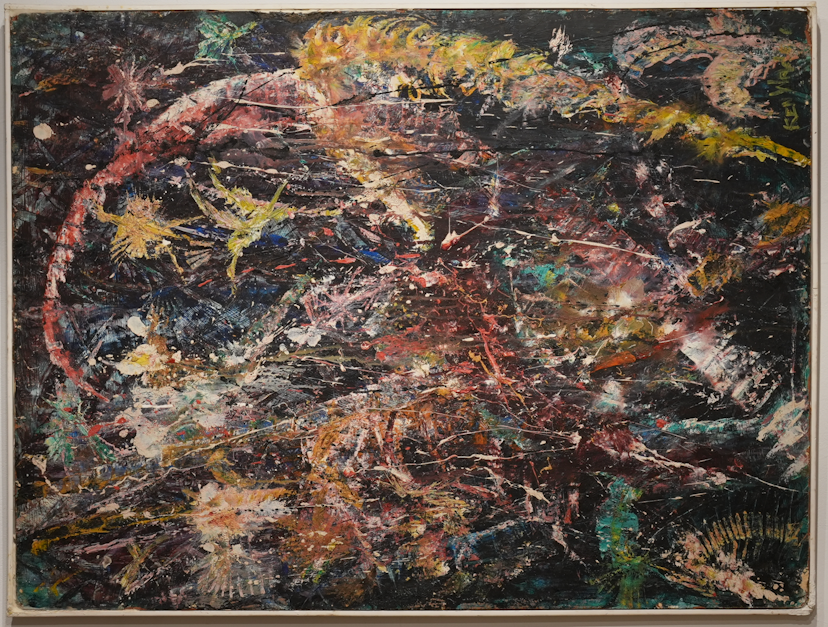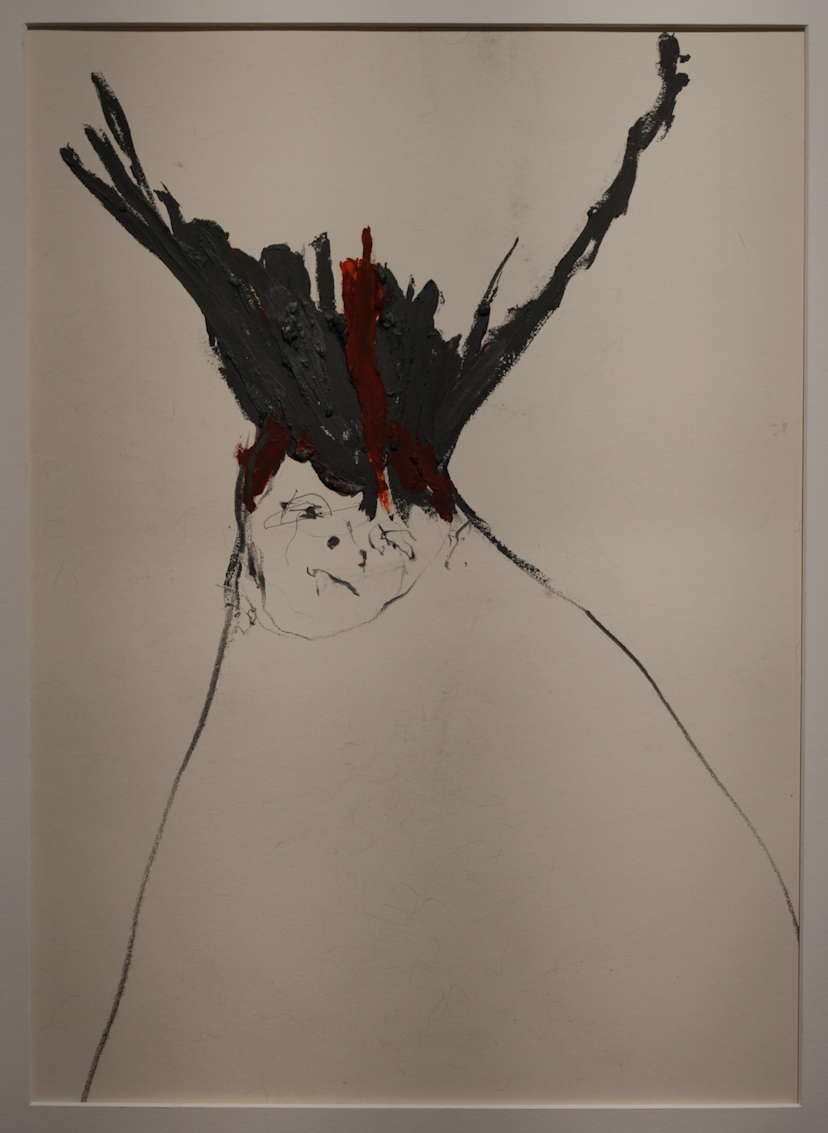001: KEN WADE
Ken Wade is a painter, sculptor, and singer who's been living and working in New York for more than 60 years. This is a story about two pencil drawings, a painting, and a person.
Having nowhere pressing to be in particular on a warm Friday afternoon, I walked to two galleries I found online (each with suspiciously few reviews).
The first I encountered, with bay windows like elbows jutting out from under a pouty face in some distractingly quiet library hall, was closed. The second took that disappointment as a challenge. In lieu of a locked door, I found — in Greenwich Village, of all places — an empty plot of land.
For some reason believing my fate would be any different another time around, I walked to Westbeth Gallery, which, with 29 reviews online, seemed like a solid option. As I approached the building, I saw an empty room with rectangles of all kinds. Some hung on the wall, bare-chested in the light; others, pulled and twisted, spinning between dirty rust and Yves Klein blue, stood on their own on the floor. Seated right by the entrance, almost hiding behind a large mahogany reception desk, the docent.
He spoke of Ken Wade, the artist whose retrospective filled and flowed through these four white atria, immediately. Ken was a natural with the pencil. He drew comic book superheroes as a kid, but his brother couldn't believe he made them. Barely 23, aboard a freight ship that took, among other things, his virginity, he floated away from the US Army — disobeying orders — into Tasmania. Glued to his chair, the gap-toothed guide said Ken began painting in 1963. Within ten minutes, all this I knew.
Time is of the essence, I guess, when there's 60 years of work to get through. In the third room, second to the right, hanging alone with a blast radius no less than 10 feet, I saw the Tasmania the guide spoke about with such hushed nostalgia.
 Birds in the Bush, 1964
Birds in the Bush, 1964The wind, which is always lonely, but here undistracted from the feeling, sweeps through this block of masonite, driving southeast. Off to chase itself again. Does it long to stay? Is that why it clings to everything here, wet without water, hot without heat? Out there, the wind can't remain still, but here, it tries. And in small pockets, it succeeds; it undoes itself unevenly, streaking through space but gripping, firm, onto bone-white bark at the bottom-right, circling around that flying fossil with wings like a toothy, open breath caught suddenly in some moment, somewhere, some time. Just a single moment. Then, the understanding: it’s not just the fossil’s moment — everything in this painting shares it. In all this brimming, there’s only one point in time. No memory, no past, no future. Only a present, relentless. How else can wind, itself just motion, stay in one place?
In the parts of this painting where the wind does blow, things have to move to find peace. The bird wearing an unripe banana's green, perched on this current, with its monstrous beak (or is that something else, another wing? a turn?) digs, somehow, into the stone. Next to it, and far below, the other birds seem prehistoric. The present seems like that, too, when it's all you see. An archaeological suntan. Bones drying in the light.
Like iron filings my attention pooled without my willing on that palm green bird and its belly studded with black. And then I saw it — it took a while — black. At first, it hides, only peeking out after an hour or so, but it's there all over the painting. Near that fresh greenness, drops like symmetric holes ringing through a page's left-hand side. Look up, then to the right and left: black swings in streaks.
In writing about the painter Walter Sickert, Virginia Woolf asks, How is [a novelist] to convey in words the mixture of innocence and sordidity, pity and squalor? Sickert merely takes his brush and paints a tender green light on the faded wallpaper. Light is beautiful falling through green leaves. He has no need of explanation; green is enough.
How can someone express all the wonder and danger and fear and chaos nestled in a single moment? How can they tell a story that doesn't unfold in time? Ken shapes lime into a bird and drips squid ink on top.
In a moment 60 years after these birds’, I found myself listening to this docent grinning through missing teeth as he told me story after story about Ken Wade.
It's a bit odd, really, how much this old man knew about the guy.
So I asked. How'd you meet Ken?
We made eye contact, and, after a few seconds, a smile bloomed onto his face. It began with the wrinkles around his eyes, jumped suddenly to his gums, and then spread to his ears and cheeks. I am him!
In the present moment, we're all in the third person. In Birds in the Bush, the palm tree — bleached, and then somehow flamingo at the tip — is in the third person as well. It’s not an “I.” And neither are our two favorite characters — that exclamation mark of a yellow bird and our green friend. Though alive, nothing in this painting remembers.
Birth of Adam i and ii (1986) are not moments; they are memory, through and through. They speak from the first person with a thick voice and pain. To be an “I”, one must remember. Memories are the wells in which our senses of self pool. They are the surface on which our identities accrete. Birds in the Bush is objective, external, present. The Adams, heavy with remembering, are subjective, internal, past.
In ii, a birth, usually so joyous, snarls with darkness. As if emerging from an eel, eyes open, mouth closed, Adam doesn't cry. His silence fills the page. It doesn't seem like anyone’s really listening, anyway. There's more at stake. One Adam lives on — he's the man around whose schedule this exhibit began so that Ken could have his son serve drinks to guests at the opening. But the other Adam, the silent one here, where is he? Where is the baby — that particular person in that particular moment — who we see in graphite here? That Adam, that human in whom relationships (father and mother, father and son, mother and son) first triangulated, where is he? If this isn't him, what is it?
It's anticipation, caked, cracking, mixed into that moment with that Adam that happened and ended, clinging on between some pocket of brain matter, swinging over and over again into presents that are not its own. Like every memory, it intrudes on some other moment's time.
 Birth of Adam, ii, 1986
Birth of Adam, ii, 1986There's graphite, oil, and pencil, yes, but there's also sorrow, abstraction, exclusion — the mother is forgotten, and the legs, too, are gone. Blood and hair remain. Who was she? What was she to Adam? What was she to Ken? That's the root of the horror, the savagery — who forgets the mother in a painting of a birth? Adam's silence pays her what little respect a baby can give. From i to ii, Adam and his mother commune, and they find within themselves some wicked incarnation: a witch emerges, her crown a clot of pubic hair, blood, and skin. Mother and son enter into myth. Legs become nothing, and the emptiness becomes.
As that emptiness forms, another trickles away. Through these drawings, Ken — in first person — comes into relief. He's not a bird in a bush or a tree in the sun. He's an "I," living and working amidst, like those Adams, many other "I"s for whom memories are more than moments lost to time.
Over the many hours I've spent at the gallery, listening to Ken's stories, some — well, most — many times, one thing is clear. Westbeth has more than just these four rooms, and, certainly, more than a handful of people, too. The gallery, I'd soon learn, sits below 383 living and working spaces built in 1970, specifically for artists. Of these 53 years, Ken's name has been on the lease for every one.
When I came to the gallery for the third time, I pulled a chair out from the closet and sat next to the two Adams for a few hours. As I got ready to leave, another resident — a painter as well — stood next to me. Ken, the dutiful docent he is, told a story about how these drawings were too lewd to be shown when he first made them. People simply couldn't handle it.
What a shame, she says. Can you imagine hearing that now? You know what I'm gonna say, Ken. These were just ahead of their time.
— Gopal Raman